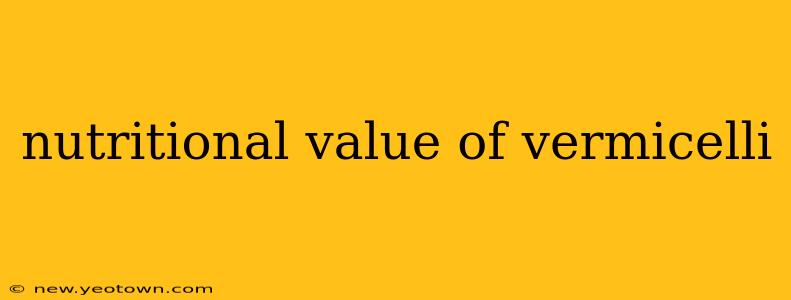Vermicelli, those delicate, thin strands of pasta, hold a special place in cuisines worldwide. From the comforting bowls of Asian noodle soups to the elegant Italian pasta dishes, vermicelli's versatility is undeniable. But beyond its culinary appeal lies a nutritional profile that deserves a closer look. Let's embark on a journey to uncover the nutritional value of vermicelli, exploring its composition, benefits, and considerations.
What is Vermicelli Made Of?
Vermicelli's core ingredient is typically refined wheat flour. This gives it its characteristic smooth texture and subtle flavor. However, variations exist. Some vermicelli varieties might incorporate rice flour, resulting in a gluten-free option perfect for those with dietary restrictions. Others might contain eggs, adding richness and a slightly firmer bite. Understanding the base ingredients is crucial in assessing the overall nutritional value.
What are the Nutritional Benefits of Vermicelli?
While vermicelli isn't a nutritional powerhouse in the same way as leafy greens or berries, it does offer some valuable contributions to a balanced diet. Primarily, it provides carbohydrates, which serve as the body's primary source of energy. These carbohydrates are easily digestible, making vermicelli a convenient and quick source of fuel.
Is Vermicelli a Good Source of Fiber?
This is a common question, and the answer is nuanced. Standard wheat vermicelli is relatively low in fiber compared to whole-wheat pasta or other whole grains. However, rice vermicelli, made from rice flour, tends to offer slightly more fiber. The fiber content plays a key role in digestion and overall gut health. Therefore, choosing rice vermicelli might be a better option if you're aiming for a higher fiber intake.
Does Vermicelli Contain Protein?
Vermicelli does offer a modest amount of protein, though it's not a significant source compared to lean meats or legumes. The protein content depends on the type of vermicelli (wheat or rice) and any added ingredients like eggs. Protein is essential for building and repairing tissues, and while vermicelli contributes, it's crucial to ensure other protein sources are included in your diet.
What are the Calories in Vermicelli?
The calorie count in vermicelli varies depending on the type, serving size, and any added ingredients. Generally, a serving of plain vermicelli falls within a moderate calorie range, making it a reasonably acceptable part of a calorie-controlled diet. However, added sauces, oils, and meats can significantly increase the overall calorie content of a vermicelli dish.
Is Vermicelli Gluten-Free?
Not always. Traditional vermicelli is made from wheat flour and therefore contains gluten. However, rice vermicelli, as previously mentioned, offers a gluten-free alternative. For individuals with celiac disease or gluten intolerance, carefully checking the ingredients list is paramount to ensure a safe choice.
How to Include Vermicelli in a Healthy Diet?
Vermicelli can be a part of a healthy diet when incorporated mindfully. Opting for whole-wheat or rice varieties increases fiber intake. Pair it with plenty of vegetables, lean protein sources, and healthy fats to create a balanced and nutritious meal. Avoid heavy sauces and excessive oils to keep the calorie and fat content in check. Think of vermicelli as a vehicle for delivering a wealth of nutrients, rather than a stand-alone food group.
Conclusion: Vermicelli – A Versatile Staple
Vermicelli's nutritional value isn't solely defined by its macro-nutrient profile but also by its place in a balanced eating pattern. Understanding the differences between wheat and rice vermicelli empowers informed food choices. While not a superfood, its versatility and ease of preparation make it a welcome addition to a healthy and varied diet. Remember to always read food labels to check the specific nutritional information for the brand and type of vermicelli you are using.

